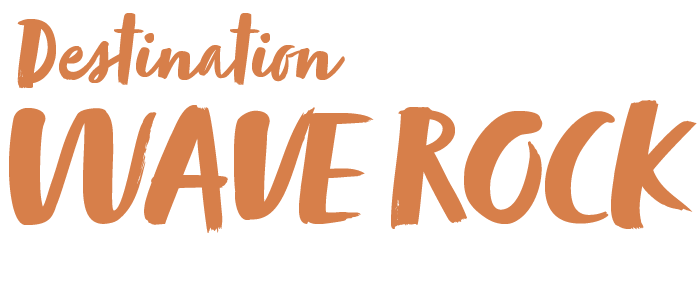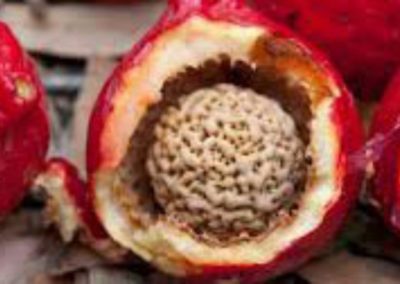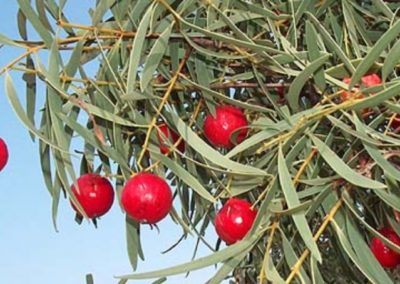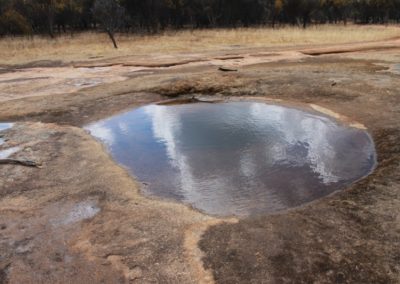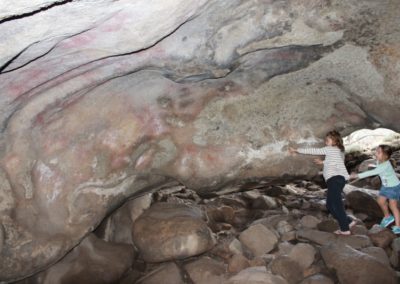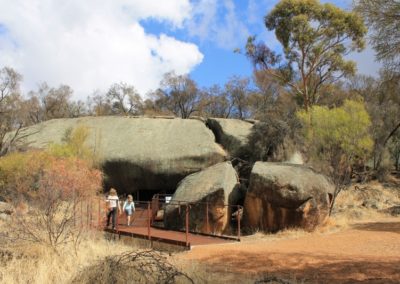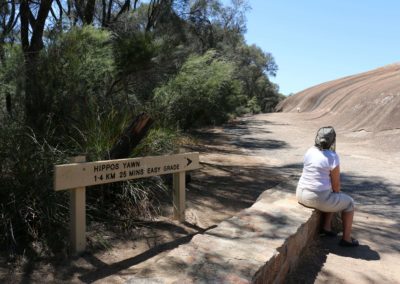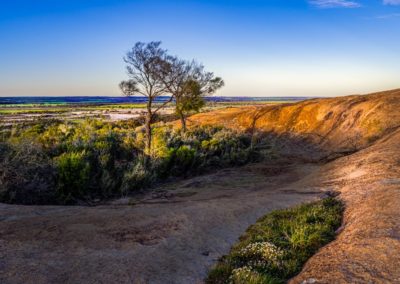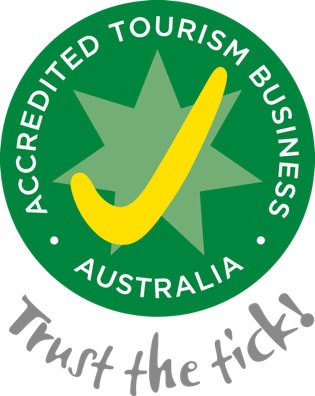
Indigenous Tours
Indigenous Tour Western Australia, Australian Aboriginal Cultural Tours
During Australian indigenous tours, you’ll see Australian Aboriginal stones and gnamma holes made and used by Aborigines that have been found on their campsites throughout the Hyden area. Australian Aboriginal art in the form of painted hand marks can still be seen on rock at the Humps. There is evidence that Aborigines resided in the area. It is thought the tribal elders proclaimed the area taboo country in the 1700’s because of Mulka’s spirit. The legend of Mulka is part of the history of the district.
Experience Aboriginal stories and Aboriginal bush tucker with our experienced guide.
Australian Aboriginal Aboriginal History
Research has shown Australian Aboriginal culture to be at least 40,000 years old, but archaeological excavations in the floor of Mulka’s Cave suggest that use of this site was relatively recent. Aboriginal Stone artifacts and bone remains were found in association with old campfires which have been dated to about 400 years ago.
Australian Aboriginal Rock Art
The dominant Australian Aboriginal art in Mulka’s Cave is hand stencils, of which there are over 140 examples representing both adults and children. Stencils are made by placing the hand on the rock then blowing over it with pigment. When the hand is removed, a negative impression remains. The reason for making hand stencils are many, but principally they are a form of signature left by those who had rights to the area.
There are also some Aboriginal line paintings which are often outlined with the finger or with a fibrous twig dipped in crushed ochre mixed with water.
Gnamma Hole
Rainfall is low and unpredictable in Australia’s arid regions, but water can be found if you know where to look. The traditional owners of these lands depended on and protected such seemingly hidden water sources for many thousands of years. One of the main sources of water for the Aboriginal people were ‘gnamma’ holes. These natural cavities are commonly found in hard rock, particularly granite outcrops, and as such act as natural water tanks which are replenished from rainwater runoff.
Gnamma holes vary in shape and depth, and the small surface area of the hole helps to minimise evaporation. Aboriginal people would lay sticks, leaves and flat rocks over the narrow opening of the gnamma holes in order to protect the precious water sources from being fouled by animals and to further prevent evaporation.
The Sheoak Tree
At the base of Wave Rock and at the rear exit of Mulka’s Cave at the Humps, you will see the Casuarina trees (sheoaks) which were often used by Aboriginal people for making wooden shields and utensils.
The Red Capped Robin
You may be lucky enough to see the Red Capped Robin flying around whilst on your travels. These birds feature in Australian Aboriginal mythology. The Robins were called Pinny Pinch or Cubbie, meaning ‘friend’. According to legend, the Robins generously gave their bright red feathers to some of the Parrots who were eager to beautify themselves.
Australian Aboriginal Bush Tucker
Traditionally the Quandong was an important Australian Aboriginal food source. It was considered a suitable substitute for meat – especially when hunting animals was in short supply. Quandong gathering and food preparation were considered indigenous “Women’s Business“. Ripe red Quandong fruits would be eaten raw or dried for later use.
Amongst Australian Aborigines, Quandongs were much valued for their medicinal properties. Specialised uses of the fruit included a form of tea which was drunk as a purgative. The tree roots were also ground down and used as an infusion for the treatment of rheumatism. Typically the leaves were crushed and mixed with saliva to produce a topical ointment for skin sores and boils. Encased within each Quandong seed is an oil-rich kernel which was also processed in a similar fashion to treat skin disorders. Quandong kernels could also be eaten and some Australian indigenous tribal groups were known to employ crushed kernels as a form of “hair conditioning oil”.

Attractions
Wave Rock & Hippos Yawn
Wildlife Park
Mulka's Cave
Wildflowers
Lake Magic
Salt Pool
The Lace Place
The Minature Soldier Museum
Pioneer Town History Museum
Hyden Street Scape Art
Stargazing Lounge
Events at Wave Rock
Accommodation
Hotel
Resort
Caravan Park
Camping
Backpackers
Tours and Trails
Walk Circut
The Rock Walk
Hyden Rock Walk
Hippos Yawn Loop
The Breakers Walk
Walk Trails and Guided Tours
Indigenous Tours
Information
About
Contact
Acknowledgements
Getting to Wave Rock
Plan your visit
Travel Advice
Hire Car
Coach Tours
Flight Tours
Eat & Drink
Bar & Bistro
Cafe
Sandalwood Restaurant
Gimlet Restaurant
Bush Bakehouse
Hyden Road House / Travel Stop
Wave Rock Hotel
2 Lynch St, Hyden WA 6359
Phone: +61429 511 511
Fax: +61 8 9880 5041
Email: [email protected]
Wave Rock Caravan Park & Resort
1 Wave Rock Rd, Hyden WA 6359
Phone: +61 8 9880 5022
Fax: 08 9880 5018
Email: [email protected]
